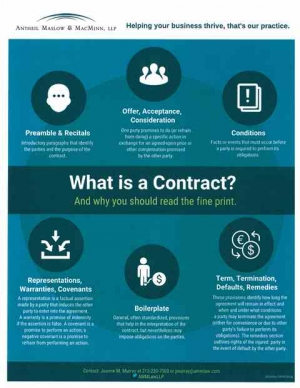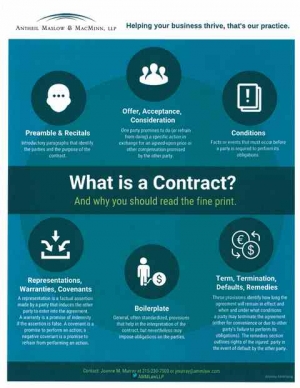Use of Corporate Authority in Internal Business Disputes
In my many years of practice as a commercial litigator dealing with conflicts between shareholders, it has become clear time and again that one of the best things business owners can do when in business with multiple shareholders or partners is to have a well-defined agreement which governs the operations of the business. Not only can that agreement memorialize the respective rights and obligations of the parties, it can also provide dispute resolution mechanisms which may serve the parties well in the event of material disagreement. Utilizing the powers granted by the Business Corporations Law and granted by the terms of an agreement governing business owners can be complex and risky but can often force an acceptable resolution when the status quo is no longer tenable.
In the case of a corporation, a shareholders agreement or by-laws will often identify the corporate office which holds supreme executive authority subject only to removal of that corporate officer by a vote of the directors. If the officer controls sufficient votes from the board, removal by a disgruntled shareholder may be impossible. The acts of the executive are subject to the business judgment rule and granted a certain amount of deference at law.
A majority shareholder who holds the top executive office is free to wield that power, consistent with the business judgment rule, in many ways - including business dealings with outside parties and, generally, with respect to employment decisions. If the disgruntled shareholder is an employee of the company, which is often the case in small business, that shareholder’s continued employment may be at the discretion of the majority. Termination of employment, if justified, is a use of corporate power which often impacts on the relative negotiating positions.
Of course, a majority shareholder who exercises corporate authority can be faced with claims that the minority has been “frozen” or “squeezed” out of the business. In such cases, it is important that the majority have “clean hands” and has avoided self-dealing, corporate waste or fraud as such allegations, if proven, could result in the appointment of a custodian or receiver and a loss of control. Certainly the majority cannot transfer the assets of the business to a new entity controlled solely by the majority. However, the existing entity can be managed in a way that maximizes benefit to the majority consistent with the exercise of business judgment. The existence of a dispute between shareholders does not in and of itself negate the discretion afforded by the business judgment rule.
AMM counsels clients through the minefield of corporate authority and with regard to available strategies to address disputes which arise between business owners.
What is a Contract: Preamble/ Recitals - Let’s begin at the beginning
This post continues my series aimed at explaining the main elements of a contract. These elements are outlined on the attached infographic. My goal is to define the key elements of a contract and to offer some tips and cautions to avoid costly mistakes as you approach these essential documents in your day-to-day business operations.
First up: the preamble and recital sections. The preamble of a contract is the introductory paragraph that identifies the parties to the agreement. It is typically followed by paragraphs known as recitals (also called the background section). Sometimes, these recital paragraphs are labeled “Whereas”. Taken together, the preamble and the recitals tell the who, what, when, and why of the transaction. In other words, they should tell the reader who the parties to the agreement are, the date of the agreement, and what the parties hope to accomplish by entering into the agreement.
As with stories told in other settings, inaccuracies and ambiguities in the preamble and recitals of a contract can cause problems down the road. One of the underlying purposes of a contract is to set forth the agreement of the parties so that their expectations can be enforced by a court or other tribunal. An accurate and detailed introduction to the contract can educate the person who is charged with resolving the dispute as to who the parties are, why they entered into the contract, and what their expectations were at the time the agreement was entered into.
One of the most common mistakes in these preliminary sections of a contract is to incorrectly name the owner of the business as a party, rather than using the entity name. This mistake results in the owner being personally obligated as a party to the contract, which is clearly not the result an owner expects after taking the trouble to incorporate.
While it may be tempting to gloss over these preliminaries without questioning their accuracy, I highly recommend taking the time to carefully review this section in every contract to be sure the story it tells is true and complete. It could prevent costly conflicts later.
Stay tuned for Part 2 of this series, which will move to the next element on the infographic: offer, acceptance, and consideration.
Joint Business Ownership: Unwinding Those Relationships Can Be Complicated and Costly
It is not unusual for business owners such as manufacturers and their suppliers and consultants to enter into joint ownership in the pursuit of mutual business goals. Those pursuing this strategy should consider that such entanglements can lead to costly future litigation should circumstances change and interests of the parties diverge. In a recent case, a dispute arose between owners of a custom manufacturing limited liability company in which AMM’s client (and a supplier to that same LLC) possessed 33 1/3% of the issued and outstanding ownership interests. The firm’s client also owned 100% of the stock in a separate business entity which supplied materials to the jointly owned custom manufacturer.
When the owners had a falling out, an issue arose with regard to the payment of outstanding invoices generated by the supplier for materials provided to the jointly owned custom manufacturer. When a resolution could not be reached, AMM, on behalf of the supplier, commenced litigation. During the litigation, the majority member of the jointly held custom manufacturer transferred all of the inventory and other assets to a newly formed entity, owned entirely by him, without the payment of consideration, that is to say, without compensating the supplier entity. The transfer of assets left the jointly held entity with insufficient assets to meet its’ liabilities; including the liabilities to the supplier. As a matter of strategy, the controlling member of the jointly owned entity allowed default judgment in favor of the supplier and against the jointly held custom manufacturer. The newly created entity went about doing business utilizing the inventory transferred without regard to the liability to the supplier.
The transfers gave rise to new and additional claims under the recently adopted Uniform Fraudulent Conveyances Act and claims of breach of fiduciary duty; all of which had to be litigated while the newly formed company operated a separate business. Clearly, a small business owner can no longer simply set up shop as a new entity when things go bad and debt accumulates. However, the complexity of ownership structure and relationship between the various entities made judicial intervention very difficult. In the end, the newly formed entity was forced to file a general assignment for the benefit of creditors; the majority owner lost his interest in all of the respective entities and eventually filed for personal bankruptcy.
The above is just one of many “war stories” encountered in attempting to unwind jointly owned business enterprises. Business owners and potential investors should think very carefully before engaging in shared ownership. What may seem like a mutually beneficial relationship at the outset can be costly and challenging to undo if things go bad in the future.
The take away for business owners and potential investors is to think very carefully before engaging in shared ownership. What may seem like a mutually beneficial relationship at the outset can be costly and challenging to undo if things go bad in the future.
What is a Contract, and Why You Should Read the Fine Print
As a business owner, you are routinely asked to “sign on the dotted line.” The document could be a purchase order, an equipment lease, or a bill of sale. Often, these documents are in fact contracts that impose obligations on the parties, even if they don’t say “Contract” or “Agreement” at the top of page one. I can’t overstate the importance of knowing what you are signing – i.e., being able to recognize a contract when you see one, as well as understanding the components of a contract and how they impact your business. I often say “think before you sign; review before you renew.”
Over the years, I have worked with many business owners who discover a little too late that they have signed a document that does not align with their intentions and may have costly consequences. For this reason, and under the theory that knowledge is power, I have put together the attached infographic to try to demystify and define the essential elements of a contract. In the coming weeks, I will be writing a series of informational blogs on each of the identified sections of this schematic to offer guidance for business owners as they approach the documents which are so essential to the health and profitability of their enterprise.
Preparing Your Business For Transition
There are many reasons why businesses sell. Certainly, the lifecycle of a successful business is often longer than the founder or controlling shareholder’s desire to continue working. In such circumstances, a business owner may wish to extract the reward for years of sweat equity by transitioning to a new ownership group. In other situations, a strategic combination is necessary to fuel continued growth in scope of services or customer reach. Sometimes, an entrepreneur must simply choose between a number of different projects such that divestiture of one opportunity becomes necessary.
Whatever the reason, preparing the business for the sale process can both enhance the value of the transaction and make for a smooth transition. A sophisticated buyer is loath to take on uncertainties, non-ordinary course liabilities or business practices which may give rise to same. A potential seller is wise to get their “house” in order before going to market or even considering discussions with a potential buyer.
Financial Reporting
Financial information is a primary focus of due diligence. Many businesses do not commission audited financial statements on an annual basis. For many more, the annual tax return stands alone as an indication of the value of the business. However, tax returns prepared without an eye on sale often reflect information designed to reflect a reduced tax liability as opposed to demonstrating the value of a going concern. A business owner is wise to consider the assistance of a qualified accounting firm to prepare corporate financial information in a light more suitable for transactional purposes. The actual filing of all applicable returns is a must.
Human Relations & Employment Practices and Policies
Human relations matters are a potential land mine. An employee handbook summarizing policies and procedures is essential. If benefits plans are in place, compliance with all applicable laws will be required if a deal is to be consummated. A current employee census and proof of citizenship or immigration status will be required. Key employees should be subject to employment agreements with assignable restrictive covenants. An acquiror will desire protection against an exodus of management.
Customers and Business Partnerships
Customer relationships and key business agreements should be locked down. An analysis of such agreements in advance with special attention to assignability or change in control provisions is necessary due diligence in any sale. Disclosure to a client or customer may make for a difficult discussion, however, a buyer will want to ensure the continuation of the business relationships prior to commitment. Indemnification obligations and intellectual property rights are certain to be addressed to the extent integral to any customer relationships.
A well-constructed house sells more readily and for greater value than a leaky one on an unstable foundation. Further, a buyer will often require representations and warranties as to the material issues summarized above such that, even after closing, a deficiency can be costly to a seller who thought the transaction was over and the profits safely secured. monetarily impactful. A seller is wise to identify and address deficiencies in advance of sale discussions both to maximize value and make for a smooth, efficient and cost effective transaction.
Attention Importers and Retailers: Move Quickly to Remove Turkmen Cotton from Your Supply Chains
Retailers, Importers, and brands need to immediately be sure there is no cotton from Turkmenistan in their supply chains. The U.S. Customs and Border Protection (CBP) has finally announced it will turn away or seize and withhold any shipments of cotton originating in the Central Asian nation of Turkmenistan. Affected importers will clearly experience a significant, and probably costly, disruption of production- related procurement. The International Labor Rights Forum (ILRF) urged the U.S. to ban Turkmen cotton two years ago but was rejected until findings of state-enforced slave labor was documented after extensive investigation.
CBP was given the authority to ban tainted products like cotton from Turkmenistan when The Trade Facilitation and Trade Enforcement Act of 2015 (TFTEA) removed the “consumptive demand” exception to the United States Tariff Act of 1930, a commonly exploited loophole to the prohibition against importing products of forced labor. Prior to the new provision, CBP used the law only 39 times since 1930 to apprehend goods tainted at some point from creation to delivery by forced labor. Since the passage of TFTEA, CBP has issued four new Withhold Release Orders (each a WRO) on specific goods from China (soda ash, calcium chloride, and caustic soda from Tangshan Sanyou Group and its subsidiaries on March 29, 2016; potassium, potassium hydroxide, and potassium nitrate from Tangshan Sunfar Silicon Industries also on March 29, 2016; Stevia and its derivatives from Inner Mongolia Hengzheng Group Baoanzhao Agricultural and Trade LLC on May 20, 2016; and peeled garlic from Hangchange Fruits & Vegetable Products Co., Ltd. on September 16, 2016).
A March 31, 2017 Executive Order establishing enhanced collection and enforcement of antidumping and countervailing duties and violations of trade and customs laws authorized the Secretary of Homeland Security, through the commissioner of CBP, to develop implementation plans and a strategy for interdiction and disposal of inadmissible goods and to develop prosecution practices to treat significant trade law violations as a high priority.
Although 2017 saw more antidumping and countervailing duty orders and intellectual property rights protection activity under TFTEA, there have been no published detentions prior to the ban of any shipments of Turkmen cotton, although CBP pledged to the U.S. Congress that more import bans under section 307 would be forthcoming. Perhaps this is just the beginning of a long awaited CBP crack-down on forced labor imports to combat human rights abuses in global supply chains.
Tattletale: Supply-Chain Investigations and the Attorney-Client Privilege
Goods Tainted by Forced Labor
Reprinted with permission from Business Law Today April 2018.
The global fight against child labor and forced labor has been led for decades by the International Labor Organization (ILO). The ILO’s most recent estimate is that 25 million people around the world, including millions of children, are currently subjected to forced labor. Under U.S. law, section 307 of the Tariff Act of 1930 prohibits the importation of merchandise mined, produced, or manufactured, wholly or in part, in any foreign country by convict, forced, or indentured labor. This law gave the U.S. Customs Service (now the U.S. Customs and Border Protection (CBP)) authority to seize commodities imported into the United States where forced labor was suspected to have been used anywhere in the supply chain.
The Tariff Act defines “forced labor” as “all work or service which is exacted from any person under the menace of any penalty for its nonperformance and for which the worker does not offer himself voluntarily.” Products of forced labor include goods that were produced by convicts and indentured laborers. The ILO defines forced or compulsory labor as service that involves coercion—either direct threats of violence or more subtle forms of compulsion under the menace of any penalty. Goods made by child labor, defined as work that deprives children of their childhood, their potential, and their dignity and that is harmful to their physical and mental development, are included in the forced-labor prohibition especially when combined with any form of indenture. Such tainted merchandise is subject to exclusion and/or seizure by the CBP, may lead to corporate criminal liability, and could even support prosecution of culpable employees individually.
The Trade Facilitation and Trade Enforcement Act of 2015 (TFTEA) removed the “consumptive demand” exception to the United States Tariff Act of 1930, which was a commonly exploited loophole to the prohibition against importing products of forced labor. Prior to the new provision, CBP used the law only 39 times since 1930 to apprehend goods tainted at some point from creation to delivery by forced labor. Since the passage of TFTEA, CBP has issued four new Withhold Release Orders (each a WRO) on specific goods from China. Although 2017 saw more antidumping and countervailing duty orders and intellectual property rights protection activity under TFTEA, there have been no published detentions to date, although CBP has pledged to the U.S. Congress that more import bans under section 307 are forthcoming.
The Thief and the Nonprofit; What’s a Board To Do?
According to the National Center for Charitable Statistics (NCCS), more than 1.5 million nonprofit organizations are registered in the U.S. We are proud to represent many such nonprofit organizations operating in the greater Delaware Valley.
These organizations serve the communities in which we live with steadfast passion and dedication. The focus on community improvement, volunteerism and charity is remarkable. We are pleased to play our small part in furtherance of their lofty goals.
Unfortunately, not everyone involved in the nonprofit industry shares the same altruistic philosophy. Invariably, we read newspaper stories about the nonprofit treasurer who diverted funds destined for an ambulance squad or the director that diverted hundreds of thousands from youth athletics programs. The question becomes, what is a nonprofit to do when defalcation is discovered?
Generally, the law imposes no duty upon an individual or organization that discovers a financial defalcation to report the facts discovered to the authorities. Only with respect to certain crimes, mostly involving abuse or child pornography, does a duty to report criminal activity arise. Under current statutory law, no such duty exists upon the discovery of a theft or diversion of nonprofit funds.
Many nonprofits are reluctant to report the defalcation. The negative publicity which follows a public disclosure can be devastating to the credibility of an organization that is already competing for donor dollars. Based on such pressures, for-profit organizations often choose to forego even the private exercise of confronting the accused in an effort to seek recovery preferring instead to simply take steps to ensure the same kind of breach of trust could not be repeated. In the nonprofit world, such private decision making is in sharp contrast to fiduciary duties owed to the organization and the moral, if not legal, duties which are founded in the donor/donee relationship. Moreover, the public nature of nonprofit tax filings may render disclosure inevitable, such that the desired privacy cannot be maintained.
Large nonprofits must file an Internal Revenue Service Form 990 each year. The form summarizes the financial performance of the nonprofit. In turn, every Form 990 that is filed is publicly available with just a few key strokes. The Form 990 requires that the organization report to the IRS whether the organization “became aware of a significant diversion of the organization’s assets” in the current year. Thus, the IRS requires the organization disclose defalcations which amount to a “significant diversion”.
Despite potential negative publicity associated with disclosure of malfeasance in nonprofit administration, the inevitability of disclosure weighs in favor of a more transparent approach. Best practices suggest that the entity’s Form 990 be reviewed by the board of directors prior to submission to the IRS, in fact, the redesigned form asks whether the tax return was furnished to the board for review prior to filing. An astute donor – particularly a business savvy donor - is likely to read the 990 with a critical eye. The worst scenario is that a director or donor becomes aware of the defalcation and subsequently questions the adequacy of management response, potentially a death knell to contributions, and the tenure of the secretive executive director.
In addition, the nonprofit’s auditor, while not required to disclose every fraud in a footnote to the financials, would need to consider whether the theft had a financial impact on the statements. If the dollar amount warranted it, it might have to be reported directly on the statements – either as a line item-loss from fraud or a receivable for repayment of stolen funds.
Further, the question of the directors’ fiduciary duties to the organization in such circumstances has not yet been addressed. Certainly, the directors of a nonprofit, having been placed in a position of trust by the organization, and bear some responsibility for effective management and control. To date, no court has imposed liability upon the directors of a nonprofit for failing to investigate potential recovery, failing to report defalcation, or failing to seek recovery of proceeds unlawfully diverted. While that is certainly not what the volunteer directors sign up for, we can see that case coming.
Navigating the potential exposure requires a complete understanding of financial controls and information, reporting requirements and the composition of the board of directors. Generally, the best advice is to conduct a complete investigation, proactively adopt whatever policies are necessary to prevent a re-occurrence, and report the bad actor to the relevant authorities. Such actions would certainly satisfy any duty to the organization.
Shareholders’ Agreements: A Vaccination Against Corporate Paralysis
In the many years I have been working as outside counsel to closely held businesses, one of the frequent pitfalls leading to costly litigation and operational conflicts is the failure of shareholders to adequately document and formalize their expectations, especially as it relates to minority shareholders. The first question I ask when contacted by a business owner who is dealing with shareholder conflicts is “What does your shareholders’ agreement say?” Unfortunately, too often, the answer is “What shareholders’ agreement?”
Many small businesses are formed by a group of people who share a collective belief at the time of formation. There are often unwritten understandings as to the division of roles within the business. Almost universally, the expectation is that all of these founding shareholders will devote ongoing resources to the business. Conflicts arise when those expectations diverge, when one shareholder fails to perform within the business, or even when a shareholder exits the company.
When conflict does arise, mechanisms for resolution can be limited, complex and expensive. Certainly a transfer of a non-performing shareholder’s stock seems like a simple straightforward course of action. However, in the absence of an agreement providing for transfer upon specified events, the business has no absolute right to remove a shareholder or force a transfer of the share ownership interest. Even a shareholder who has ceased to be actively involved in the business continues to enjoy all of the rights attendant to the ownership of the shares: the shareholder need not come to work, need not contribute capital, need not pursue business opportunity in the name of the company. Employment may end, but the right to enjoy distribution of profits does not, as long as share ownership persists. As most small businesses are organized as subchapter “s” corporations, profits must be distributed in accordance with share percentage.
Ownership of stock gives rise to all of the rights provided by statute. Minority shareholders enjoy the right to obtain information about the performance of the company, attend and vote at shareholders’ meetings, and receive distributions of profits derived from corporate operations. Minority shareholders can be an impediment to stock transfers, anchors against change and obstacles to capital expenditures. Such situations are a constant bone of contention among owners of small businesses.
Of course, the best solution is an agreement that accurately reflects the understandings of the shareholders at the time the shares are assigned, or the company is formed. Such agreements can provide clearly defined roles within the business, mandatory transfer upon termination of employment, death or disability, valuation mechanisms and provisions restricting transfer. Adopting an agreement, at minimum, provides a foundation for the business relationship, and may provide a roadmap in the event of disagreement.
In the absence of an agreement, a dispute with a minority shareholder requires careful management. The majority must take care to avoid vesting a minority shareholder with breach of fiduciary duty claims or shareholder oppression. Compliance with corporate formalities is imperative. While there is no guaranty of continuing employment for a minority shareholder (with exceptions), distributions or profits in accordance with ownership percentages is required if the company has elected “s” corporation treatment. Certainly, majority and employed shareholders may receive compensation for services rendered, but an artificial manipulation of corporate profits would certainly be relevant to a minority shareholder oppression claim.
Pennsylvania Business Corporations Law provides little relief to a majority shareholder who continues to run a profitable business without the assistance of his or her minority shareholders. The statute provides no right to extract a non-performing shareholder against his/her will at any price, and provides no absolute right of liquidation. Even the nuclear option of judicial corporate liquidation requires that the complaining shareholder allege irreparable harm to the company; an allegation which may be impossible if the business is successful as a result of the majority’s efforts.
Formation of an appropriate and workable shareholders’ agreement requires legal representation; as does management of divergent goals between shareholders. Owners of s corporations with minority shareholders would be wise to review their governing documents and take proactive steps to safeguard the future value of their shares, and avoid crippling and costly litigation. Antheil Maslow and MacMinn business attorneys are highly experienced in such matters and leverage a team of professionals in differing disciplines to navigate these complex waters.
Legislative Updates Owners of PA LLC’s & Partnerships Need to Know – Part 2
Earlier this year, amendments to Pennsylvania’s statutes governing partnerships and limited liability companies (often referred to as unincorporated entities or alternative entities) went into effect. I recently blogged about the “transferable interest” concept adopted by the Act. Today, in Part 2 of this series, I highlight another significant change brought about by Act 170: the clarification of the fiduciary and other duties owed in the context of an unincorporated entity. In general, there are three basic duties:
• Duty of loyalty: generally, a duty to avoid self-dealing, competing and usurping company or partnership opportunities
• Duty of care: a duty to refrain from gross negligence and recklessness
• Duty of good faith and fair dealing: a duty to deal fairly and consistently with the terms of the parties’ agreement and the purpose of the entity
In a general partnership, each partner owes the above duties to each of the other partners and to the entity.
In a limited partnership: (a) the general partner owes each of these duties to the limited partners and to the partnership; and (b) the limited partners owe only a duty of good faith and fair dealing to each other.
In a manager-managed LLC: (a) the manager owes these duties to the members and to the entity; and (b) the members owe a duty of good faith and fair dealing to each other. In a member-managed LLC, the members owe these duties to each other and the company.
Some of these duties may be modified by agreement of the parties. In their operating or partnership agreement, the parties may modify, but not eliminate, the duty of loyalty and the duty of care, as long as the modification is not “manifestly unreasonable.” This standard is not defined and is left to the courts to interpret, but in general the agreement cannot convert the relationship into a strictly arm’s length relationship. The duty of good faith and fair dealing may not be modified or removed, but the owners’ agreement can identify the standards by which this duty will be measured.






























